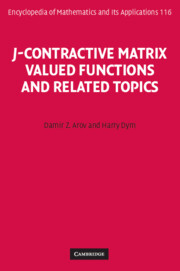Book contents
- Frontmatter
- Contents
- Preface
- 1 Introduction
- 2 Algebraic preliminaries
- 3 The Nevanlinna class of meromorphic mvf's
- 4 J–contractive and J–inner matrix valued functions
- 5 Reproducing kernel Hilbert spaces
- 6 Operator nodes and passive systems
- 7 Generalized interpolation problems
- 8 Generalized Krein extension problems
- 9 Darlington representations and related inverse problems
- 10 More criteria for strong regularity
- 11 Formulas for entropy functionals
- Bibliography
- Notation index
- Subject index
3 - The Nevanlinna class of meromorphic mvf's
Published online by Cambridge University Press: 10 May 2010
- Frontmatter
- Contents
- Preface
- 1 Introduction
- 2 Algebraic preliminaries
- 3 The Nevanlinna class of meromorphic mvf's
- 4 J–contractive and J–inner matrix valued functions
- 5 Reproducing kernel Hilbert spaces
- 6 Operator nodes and passive systems
- 7 Generalized interpolation problems
- 8 Generalized Krein extension problems
- 9 Darlington representations and related inverse problems
- 10 More criteria for strong regularity
- 11 Formulas for entropy functionals
- Bibliography
- Notation index
- Subject index
Summary
The first half of this chapter summarizes a number of basic definitions and facts on the Nevanlinna class of meromorphic scalar and mvf's of bounded Nevanlinna type in ℂ+. Special attention is paid to the subclasses associated with the names of Schur, Carathéodory, Smirnov, and Hardy and a subclass of pseudomeromorphic functions for use in the sequel, mostly without proof. For additional information, the books of de Branges [Br68a], Dym and McKean [DMc76] and Rosenblum and Rovnyak [RR94] are recommended for scalar functions; Helson [He64], Rosenblum and Rovnyak [RR85] and Sz-Nagy and Foias [SzNF70] are good sources for matrix and operator valued functions. The article by Katsnelson and Kirstein [KK95] also contains useful information.
In the second part of this chapter, characterizations of the Nevanlinna class of mvf's and some of its subclasses in terms of the domain and range of the operator of multiplication by a mvf f in the class under consideration acting between two Hardy H2–spaces of vvf's (vector valued functions) will be presented. Inner–outer factorizations and the notions of denominators and scalar denominators will also be developed in this part.
The symbols ℂ, ℂ+ [resp., ℂ–] and ℝ will be used to denote the complex plane, the open upper [resp., lower] half plane and the real line, respectively; ℝ+ = [0, ∞) and ℝ– = (−∞, 0].
- Type
- Chapter
- Information
- J-Contractive Matrix Valued Functions and Related Topics , pp. 83 - 168Publisher: Cambridge University PressPrint publication year: 2008



